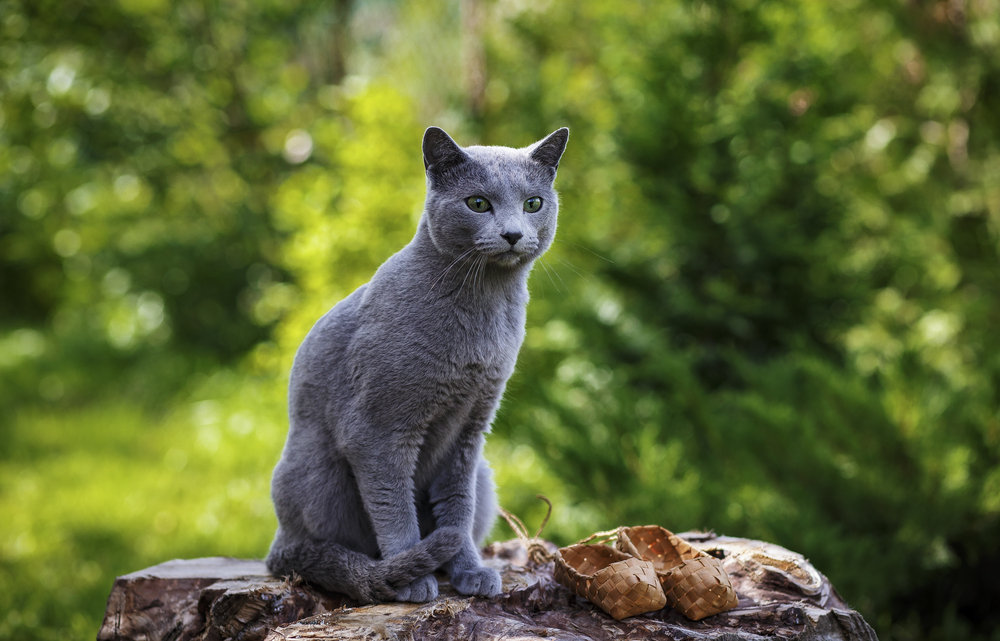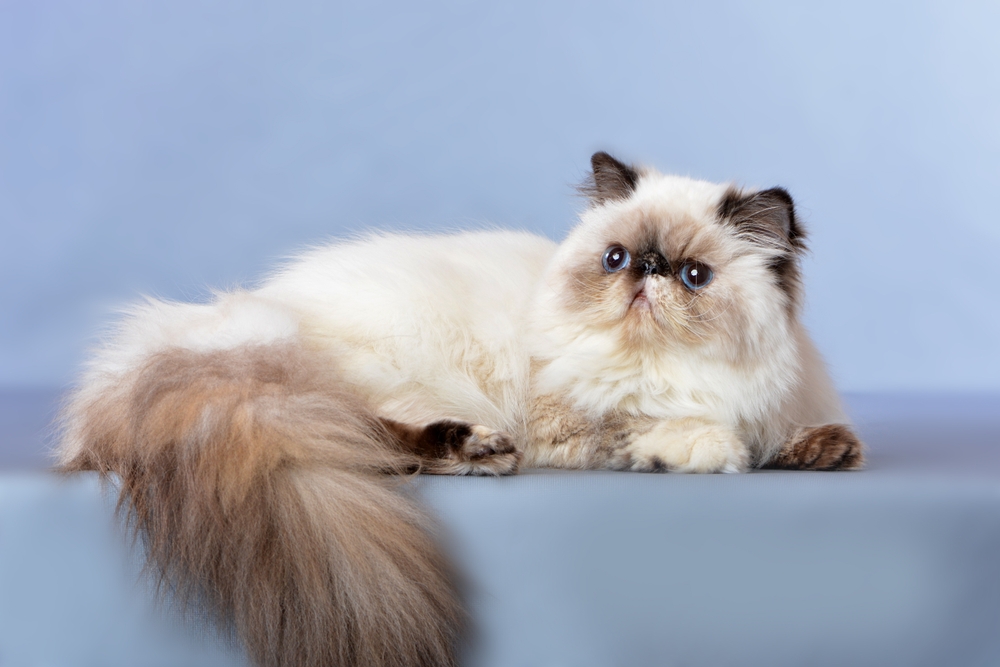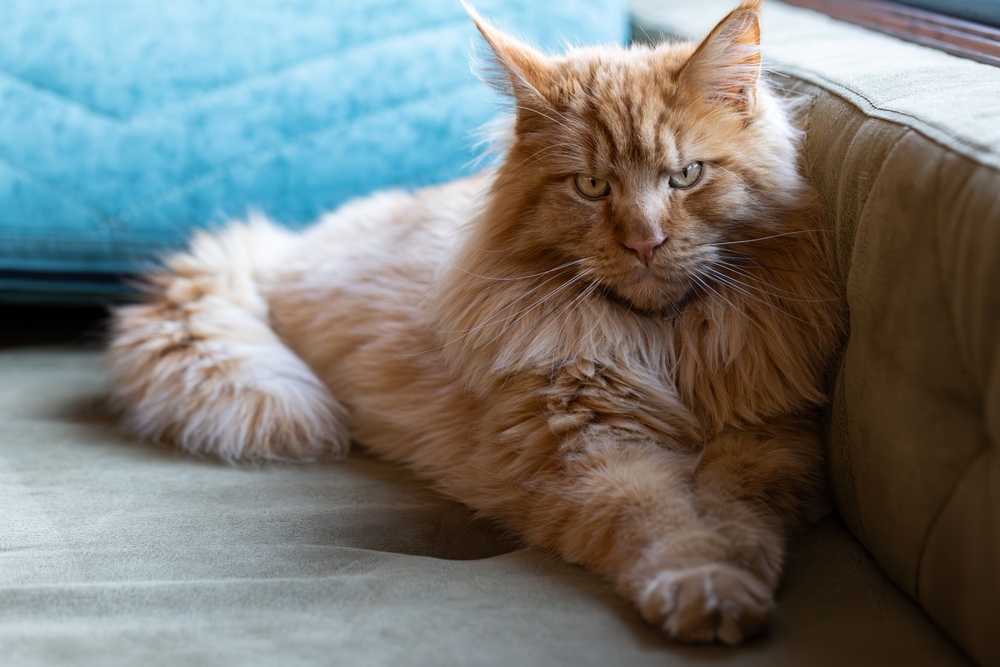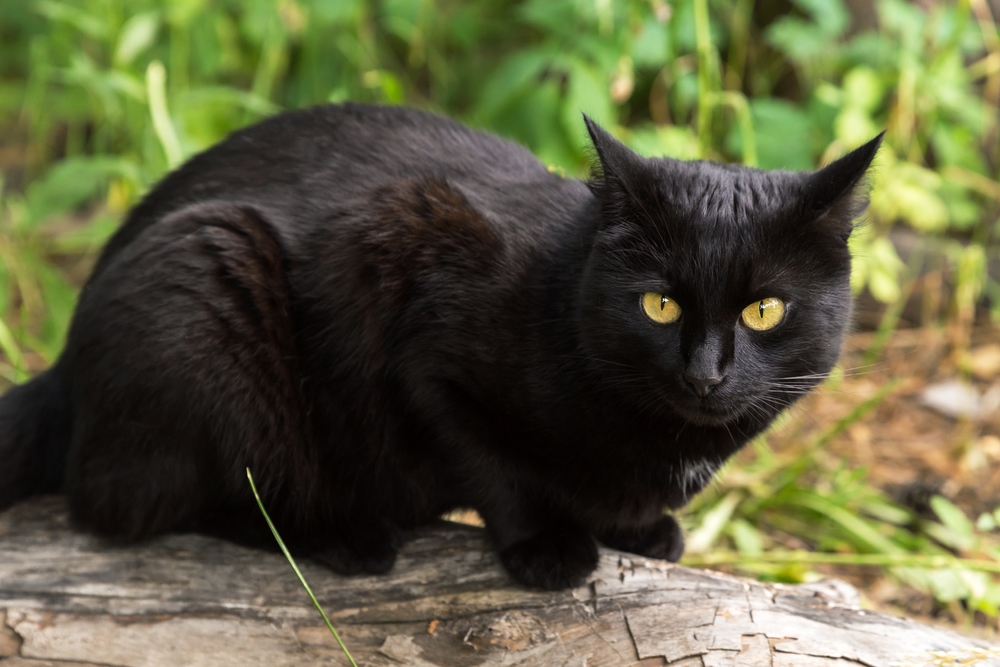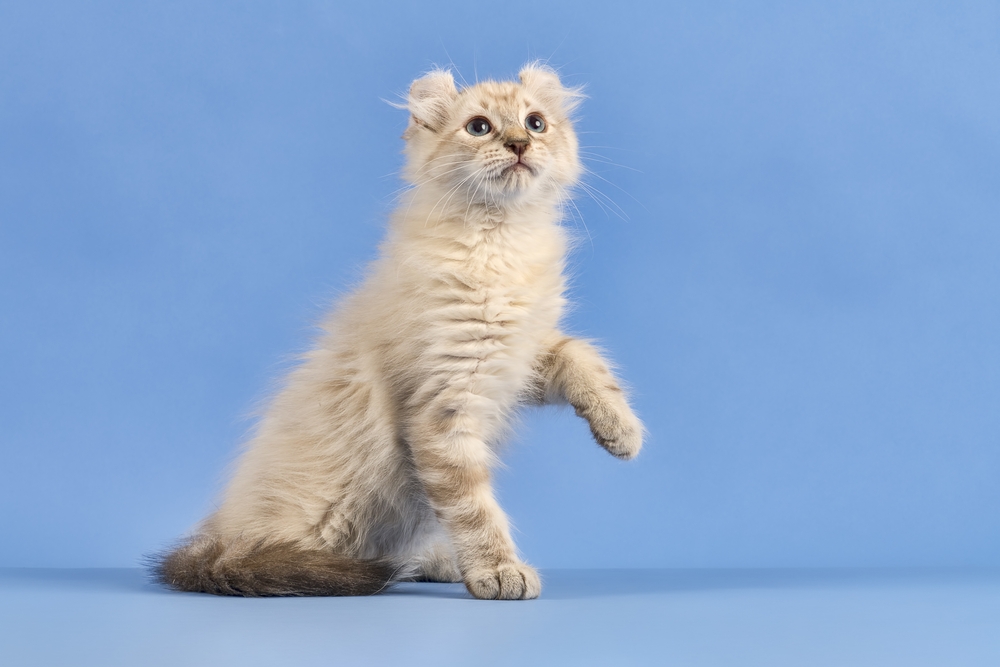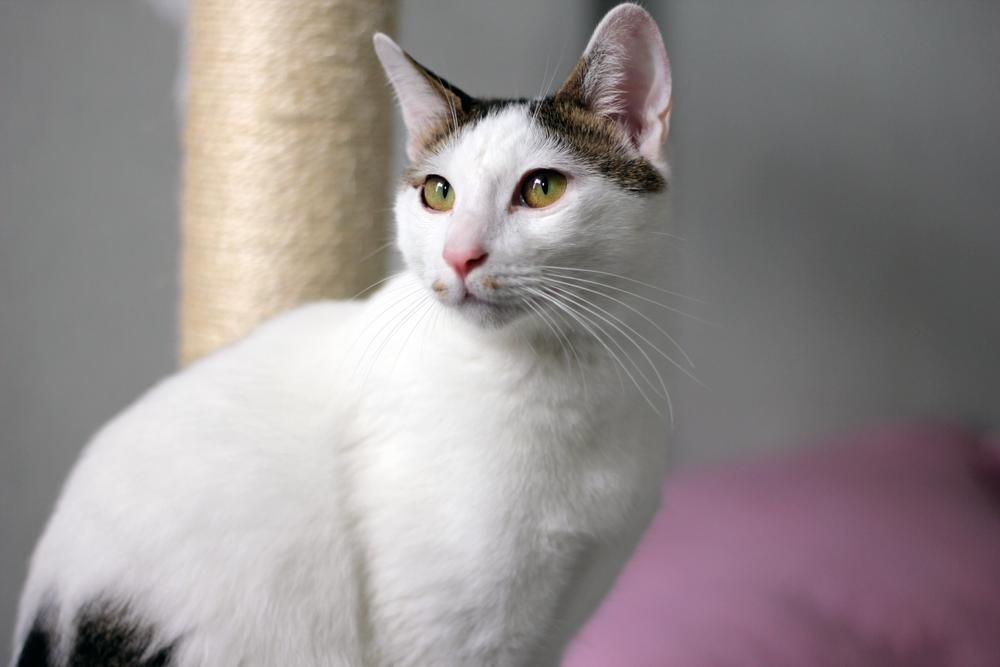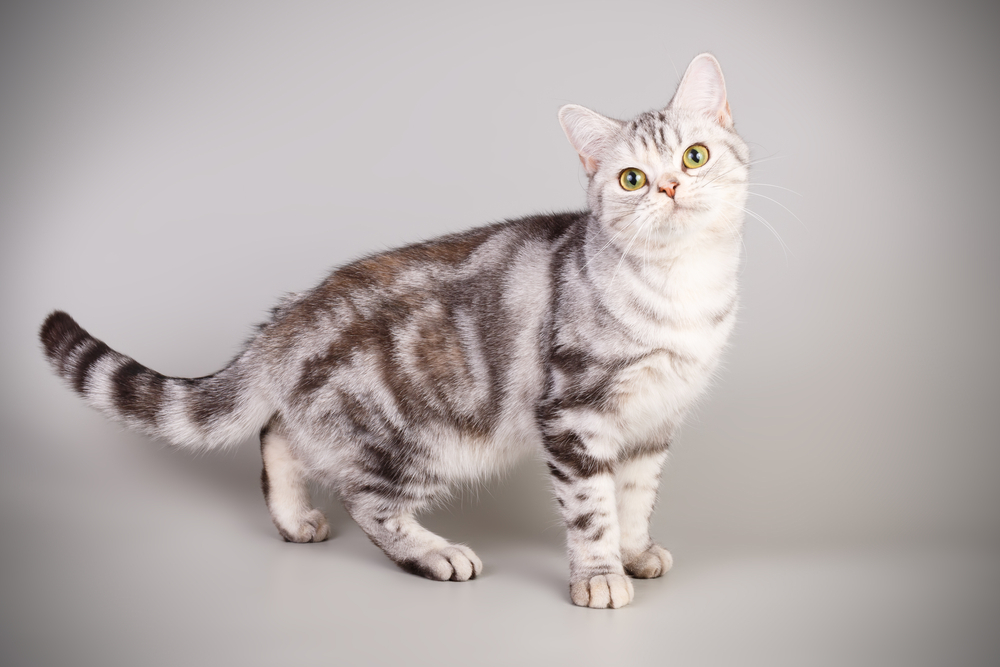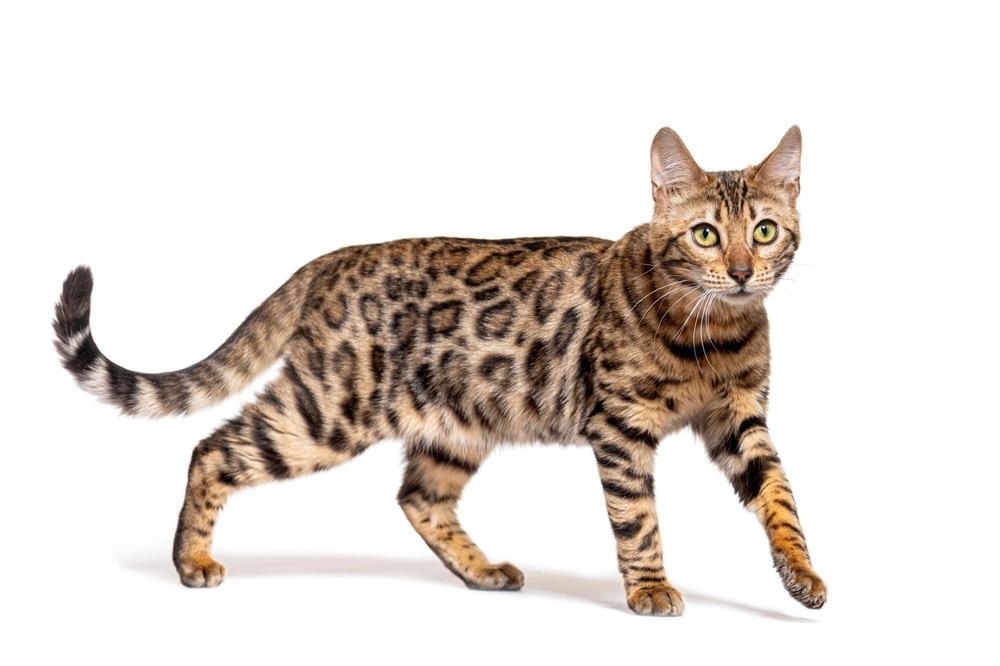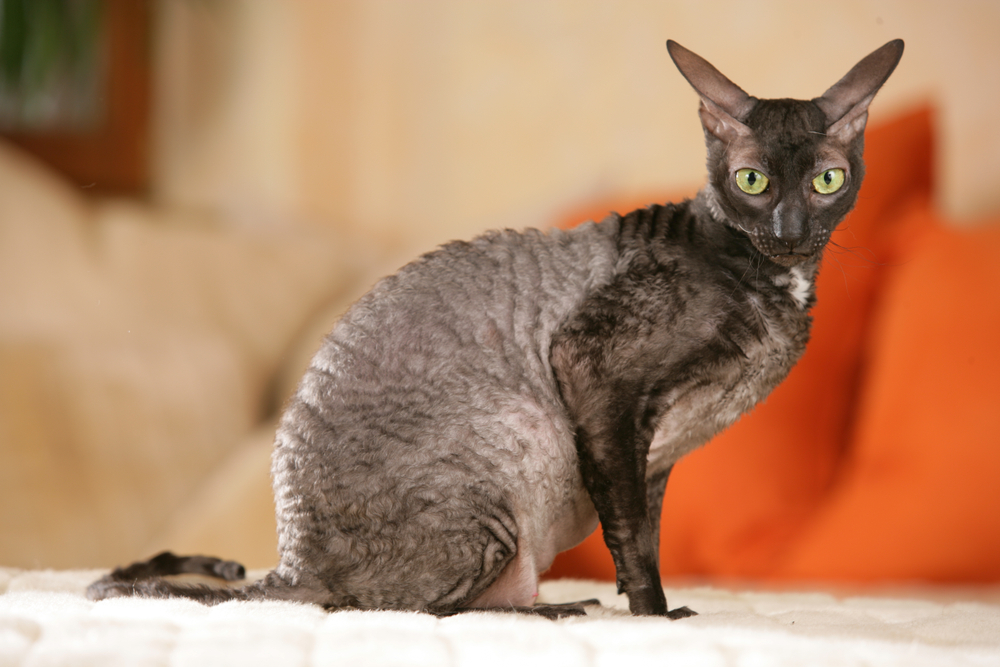The Russian Blue is closely related to the Chartreux (France) and the British Blue Shorthair (UK), as all share solid blue-gray coats, though the Russian Blue is sleeker and more refined in build. In the wild, its slender frame and plush coat resemble the European wildcat (Felis silvestris silvestris), which also thrives in colder northern climates.
About
The Russian Blue is a graceful, medium-sized cat breed admired for its shimmering silver-blue coat, vivid green eyes, and gentle, reserved personality. Its body is slender yet muscular, with long legs, a fine-boned frame, and a slightly upturned mouth that gives it a subtle “smiling” expression. The short double coat is plush, dense, and soft to the touch, with a silvery sheen that adds to its refined elegance.
The Russian Blue (Felis catus), of the family Felidae, is believed to have originated in northern Russia, particularly around the port city of Arkhangelsk, where its dense coat evolved to withstand harsh climates. Sailors are thought to have brought the breed to Europe in the 19th century, and it gained recognition in England and Scandinavia before spreading worldwide. Selective breeding refined its features, and it remains one of the most elegant and recognizable shorthair breeds today.
Typically weighing 7–12 pounds (3.2–5.4 kg), the Russian Blue is lean but muscular, with a graceful presence. Its double coat requires little grooming beyond weekly brushing, as it rarely mats and sheds minimally.
Temperamentally, Russian Blues are intelligent, gentle, and somewhat reserved. They often form deep bonds with their families but may be shy or cautious around strangers. Unlike more demanding breeds, they are quiet and undemanding, preferring stability and routine. However, they enjoy play and interaction with their trusted companions, often displaying surprising agility and problem-solving skills.
The Russian Blue’s combination of beauty, elegance, and calm, affectionate personality makes it a cherished choice for cat lovers seeking a refined, loyal, and low-maintenance companion.
Physical Characteristics
Coat: The Russian Blue’s most defining feature is its short, dense double coat, which feels plush and velvety, almost like seal fur. The coat is a solid blue-gray color with a distinct silvery sheen caused by the way light reflects off the translucent tips of the guard hairs.
Face: They have a medium-sized, wedge-shaped head with a straight nose and prominent whisker pads, which give them a slight smile-like expression. Their large, wide-set eyes are a vivid emerald green, one of the breed’s most striking features.
Body: The Russian Blue has a slender, fine-boned, yet muscular body with long legs, a graceful neck, and a lithe, athletic frame. Their overall build is elegant but strong.
Ears: Large, pointed, and wide at the base, set upright to emphasize their alert, curious look.
Tail: Long and tapering, proportionate to their body, and covered with the same silvery-blue fur.
Size:
-
Length: 15–18 in (38–46 cm) from head to base of tail.
-
Height: 9–11 in (23–28 cm) at the shoulder.
Weight:
-
Adult Female: 7–10 lbs (3.2–4.5 kg).
-
Adult Male: 10–12 lbs (4.5–5.4 kg).
The Russian Blue’s combination of a shimmering blue-gray coat, vivid green eyes, and elegant yet muscular framemakes it one of the most graceful and distinctive cat breeds in the world.
Reproduction
Mating and Courtship:
Russian Blues usually reach sexual maturity at 8–12 months, though responsible breeders often wait until at least 12 months before breeding. Queens in heat display increased vocalization, rubbing, rolling, and affectionate behavior. Males respond with pursuit, calling, and courtship.
Breeding Season:
They can breed year-round, though queens often cycle more frequently in spring and summer due to longer daylight hours.
Gestation:
The gestation period lasts about 63–65 days (around 9 weeks).
Birth of Kittens:
Typical litter size is 3–6 kittens. Russian Blue kittens are born with blue-gray coats and blue-gray eyes, but their eye color changes as they age, gradually shifting to the breed’s signature vivid green by 4–6 months of age.
Care and Nurturing:
Kittens are born weighing about 3–4 oz (85–113 g), blind and dependent. Queens are generally very attentive mothers, keeping their kittens warm, fed, and clean.
Weaning and Social Development:
-
Eyes open between 7–10 days.
-
Walking begins around 3 weeks.
-
Solid food introduced by 4–5 weeks, with full weaning at 8–10 weeks.
-
Kittens’ playful, inquisitive nature emerges early, reflecting the breed’s intelligence and alertness.
Independence:
By 12–14 weeks, kittens are ready for adoption, having developed litter training, socialization, and early hunting/play skills. Breeders typically keep Russian Blue kittens until at least 12 weeks to ensure proper health and emotional maturity.
The Russian Blue’s reproductive cycle follows the same pattern as most domestic cats, but their unique eye color transformation—from blue at birth to brilliant green in adulthood—makes their kitten development especially distinctive.
Lifespan
Lifespan in the Home:
Russian Blues are a long-lived and hardy breed, with an average lifespan of 15–20 years. Many live well into their late teens when provided with proper care, nutrition, and veterinary attention.
Lifespan in Outdoor or High-Risk Settings:
When allowed outdoors, Russian Blues face dangers such as traffic, predators, and disease, reducing their average lifespan to 7–10 years.
Factors Affecting Longevity:
-
Genetics: Russian Blues are considered one of the healthier pedigreed breeds, with relatively few inherited disorders compared to others. They are occasionally prone to obesity if overfed, which can impact longevity.
-
Diet & Exercise: A balanced, high-protein diet and regular play help maintain their lean, muscular frame. Portion control is essential, as their calm temperament can make them less active than high-energy breeds.
-
Preventive Care: Routine veterinary visits, dental cleanings, and vaccinations extend their lifespan and overall health.
-
Environment: Indoor living with enrichment (climbing trees, toys, interactive play) supports mental stimulation and reduces stress.
Notable Longevity:
Some Russian Blues have been reported to live beyond 20 years, placing them among the longest-lived domestic cat breeds.
The Russian Blue’s combination of robust health, minimal genetic issues, and calm temperament makes it one of the most resilient and long-lived cat breeds when given attentive care.
Eating Habits
Diet:
Russian Blues are obligate carnivores and need a high-protein, meat-based diet to maintain their lean muscle mass. Premium commercial cat foods—wet, dry, or a mix—should meet AAFCO feline nutrition standards. Wet food is especially beneficial for hydration, while dry kibble can help with dental health.
Feeding Frequency:
-
Kittens (up to 6 months): 3–4 small meals daily to support rapid growth.
-
Adults (6 months–10 years): 2 meals daily, portioned to prevent overeating.
-
Seniors (10+ years): Smaller, more frequent meals with senior-specific formulas for kidney, heart, and joint health.
Special Considerations:
-
Russian Blues are prone to overeating and obesity, since they love food and can be less active than high-energy breeds. Portion control is essential.
-
Their plush double coat can hide weight gain, so regular weighing is recommended.
-
Diets rich in omega-3 and omega-6 fatty acids help maintain their shiny silver-blue coat.
-
Fresh, clean water should always be available to support kidney and urinary tract health.
Treats:
Healthy treats such as freeze-dried meat, cooked chicken, or commercial cat treats can be given sparingly, but should not exceed 10% of daily calories.
Feeding Enrichment:
Russian Blues are intelligent and benefit from puzzle feeders, slow-feeding bowls, or treat-dispensing toys, which keep them mentally engaged while preventing overeating.
The Russian Blue’s eating habits reflect its calm, food-loving nature—they thrive on portion-controlled, protein-rich meals paired with engaging feeding routines to support their long lifespan and elegant physique.
Uniqueness
Shimmering Blue Coat:
The Russian Blue’s solid blue-gray coat with a silvery sheen is one of the most recognizable in the cat world. Its plush double coat feels like velvet and sets it apart from nearly all other shorthaired breeds.
Brilliant Green Eyes:
One of the breed’s most striking features is its vivid emerald-green eyes, which develop as kittens grow—starting blue at birth and transitioning to green by 4–6 months.
Reserved Yet Loyal Personality:
Russian Blues are known for being gentle, quiet, and somewhat reserved around strangers but deeply affectionate and loyal with their families. They often bond strongly with one or two people.
Intelligent and Observant:
Highly intelligent and curious, Russian Blues quickly learn routines, enjoy puzzle toys, and are often described as thoughtful and graceful in behavior.
Hypoallergenic Qualities:
Though not entirely hypoallergenic, Russian Blues produce lower levels of Fel d 1 protein, which causes many cat allergies. This makes them more tolerable to some allergy sufferers compared to other breeds.
Elegant Build:
Their slender yet muscular body, long legs, and graceful movements give them a regal, almost aristocratic appearance.
Historic and Mysterious Origins:
The Russian Blue’s origins are thought to trace back to Arkhangelsk, Russia, where cats with silvery-blue coats were noted in the 19th century. Their mysterious background adds to their allure.
The Russian Blue’s combination of shimmering coat, emerald eyes, refined temperament, and hypoallergenic reputation makes it one of the most unique and distinguished cat breeds in the world.
Be the First to Share Photos of This Species.
FAQ’s
1. What is the closest species or breed to the Russian Blue?
2. How does the Russian Blue compare to other cats?
Russian Blues are more reserved and gentle than outgoing breeds like the Siamese or playful breeds like the Abyssinian. They are less vocal, with a soft, quiet voice, and prefer calm households. Their shimmering blue coat and striking green eyes make them stand out visually, while their tendency to bond strongly with one or two people sets them apart behaviorally.
3. What national parks or regions provide the best chance to see a cat resembling the Russian Blue?
While no wildcat perfectly mirrors the Russian Blue’s silver-blue coat, cats with similar builds or coloration can be seen in colder or forested regions:
-
Russian Arctic region – near Arkhangelsk (Russia): Considered the Russian Blue’s place of origin, feral populations still exist.
-
Białowieża Forest, Poland/Belarus: Home to the European wildcat, which shares the Russian Blue’s size and forest adaptations.
-
Siberia’s Taiga (Russia): Habitat of long-furred wildcats adapted to harsh climates, resembling the Russian Blue’s dense double coat.



































































